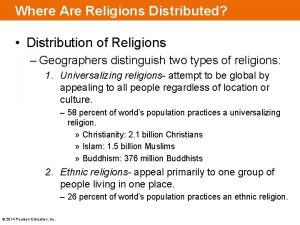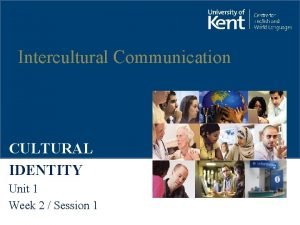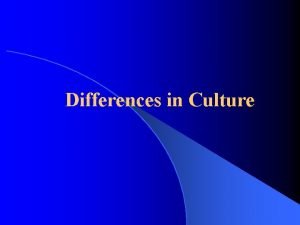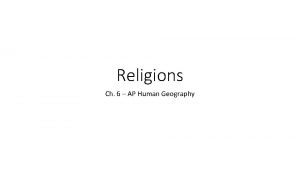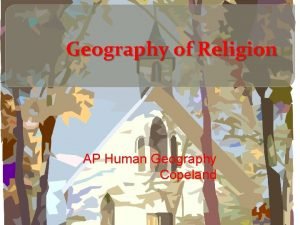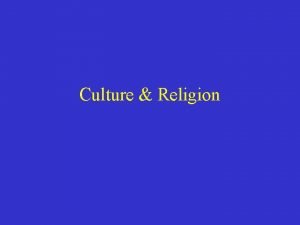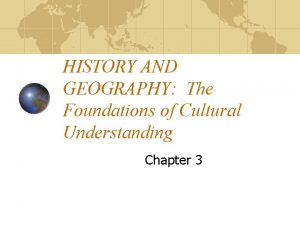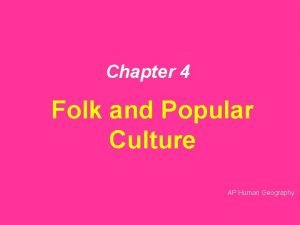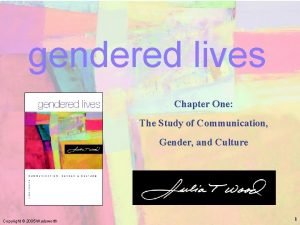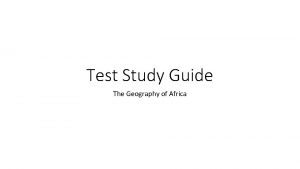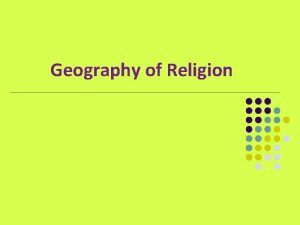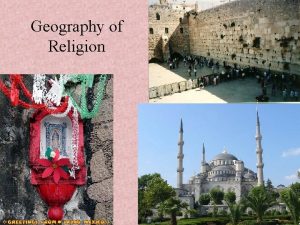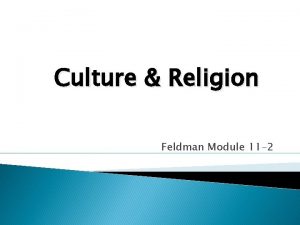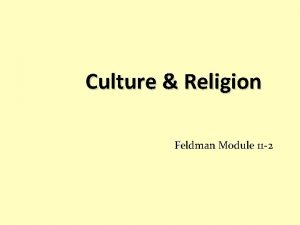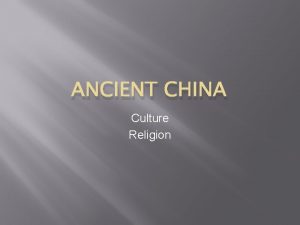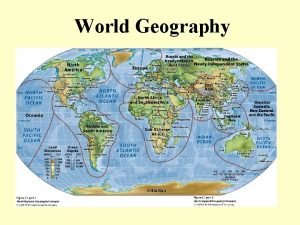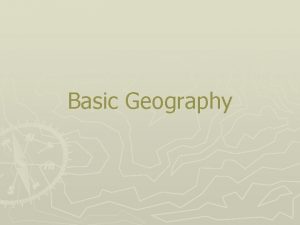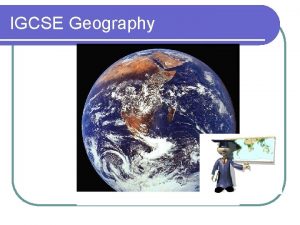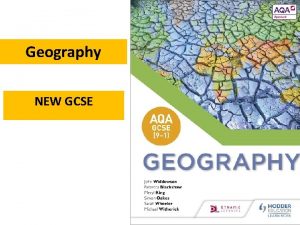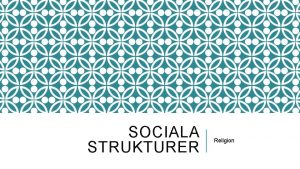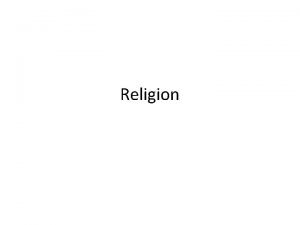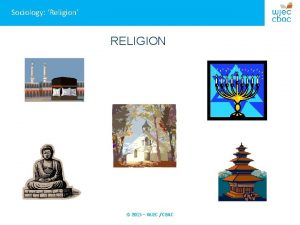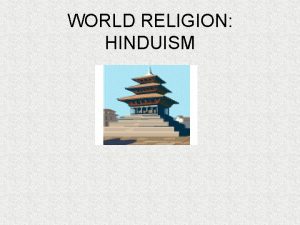Culture Religion Geography of Religion Why is study










































- Slides: 42

Culture & Religion

Geography of Religion • Why is study of religion important? – Religion lies at the root of culture and identity. – The cultural landscape is marked by religion. – Religious conflicts over territory are at the source of contemporary struggles, ex. Israel, N. Ireland, and Kashmir (dispute between Hindu India and Muslim Pakistan). • What do we study? • Aspects of religion – How is religion distributed geographically? – How does religion mark the landscape?

Stonehenge (England) Geographers- study the diffusion of religion and the conflicts that may arise. Topics: *They are concerned with regional distribution of different religions and potential for conflict. (Where and Why? ) *Regions: They study spatial connections of religion 1. *Scale and Globalization *Religion leaves a mark on the 2. physical landscape Why is there tension with Religions? (5 reasons) Religion is an essential element of who we are. (culture) Some religions designed to appeal world wide others to ethnic groups. 3. How they organize the landscape 4. Adopting of global religions, requires turning away from ethnic religions. 5. Take religion to new location when migrate

5000 Years of Religion The Geography of Religion in 90 seconds How has the geography of religion evolved over the centuries, and where has it sparked wars? Our map gives us a brief history of the world's most well-known religions: Christianity, Islam, Hinduism, Buddhism, and Judaism. http: //www. mapsofwar. com/ind/history-of-religion. html

World Distribution of Major Religions Not evident on the map are the local variations in practices, as well as the many smaller religions that are practiced worldwide (e. g. , Sikhism , Voodooism, Santeria).

The U. S. Geography Religion of Religion in Landscape Survey the US America is a Pluralistic Nation with many religions but immigration and migration patterns have impacted where these religions were primarily located http: //wp. patheos. com. s 3. amazonaws. com/blogs/b lackwhiteandgray/files/2 012/07/USA-religionmap. jpg http: //religions. pewf orum. org/maps

Types of Religion Universalizing vs. ethnic religions • Universalizing religions – attempt to be global, to appeal to all people wherever they live – 58% of world’s population (Christianity, Islam, Buddhism) • Ethnic religions – appeal to one group of people living in one place – 26% (Hinduism, Confucianism, Taoism, Shintoism, Judaism, ethnic African religions – Not focused on Conversion – mostly born into the religion • No religion – 16% of world’s population

Where are religions Distributed? Universalizing religions: Global and appeal to all. Ethnic religions: one group in one place. 3 of worlds leading Universalizing religions: Christianity, Islam, Buddhism. Religions organization: Divided into 3 parts: 1. Branches– large fundamental divisions in a religion 2. Denominations- a division of the Branch 3. Sect- a small group broken away.

(1). Branches of Christianity- 3 large branches— most dispersed religion- 2 billion 1. Roman Catholic (RC) 52% 2. Protestant 21% 3. Eastern Orthodox 10% 4. And 22% Christians who don’t belong to Church (*90% of people in the western hemisphere are Christian Minority Christian Groups: - Most of these branches are isolated b/c of differences in doctrine & b/c Islamic control in S. W. Asia & North Asia - Ex: 2 small groups in Africa = - Coptic Church of Egypt - Ethiopian Church - Started by 2 shipwrecked Christians who converted the king in the 4 th century

2. Denominations A division of a branch of a religion that unites a number of local congregations in a single legal and administrative body Lutherans = Protestant Denomination *The world's largest religious denomination is Sunni Islam, followed by Roman Catholicism

Christian Branches in the U. S. Distribution of Christians in the U. S. Shaded areas are counties with more than 50% of church membership concentrated in Roman Catholicism or one of the Protestant denominations. What does the different regions of religion tell us about settlement patterns of the USA? This was an AP map question.

(3)Sects of Religion Ex: Southern Baptists The word Southern in Southern Baptist Convention stems from a split from northern Baptists over the issue of whether slave owners could serve as missionaries. After the American Civil War, another split occurred when most freedmen set up independent congregations. Many set up their own Baptist churches, regional associations, and state and national conventions, such as the National Baptist Convention, which became the second largest Baptist convention. Others joined new African-American denominations, chiefly the African Methodist Episcopal Church.

Origin Areas and Diffusion of Four Major Religions The world’s major religions originated in a fairly small region of the world. Judaism and Christianity began in present-day Israel and Jordan. Islam emerged from western Arabia. Buddhism originated in India, and Hinduism in the Indus region of Pakistan (from Vedic rites and rituals). Religious beliefs are organized and codified, often based on the teachings and writings of one or more of its founders.

Spread of Buddhism Commercial routes, like the Silk Road, were important vectors for the spread of the religion across Asia.

Spread of Christianity in Europe • Christianity diffused through Europe largely because of missionary efforts. • Monks and monasteries were especially important as hubs of diffusion in the larger network. • The shaded areas indicate places where Christian converts dominated by A. D. 300.

Holy Places = Sacred Spaces • Religions establish special places that localize the sacred in the midst of ordinary space. • Commemorate great religious events of the past or are places of special significance to religion. Holy Places different meaning for Ethnic and universal religions. Universal Religions holy places are associated with the person. Ethnic religions holy places are concentrated and connected with physical environment.

Ethnic Holy Places: Hindu Connected with relationship between human beings and nature Fig. 6 -11: Hierarchy of Hindu holy places: Some sites are holy to Hindus throughout India; others have a regional or sectarian importance, or are important only locally. Cosmogony– set of religious beliefs concerning the origins of the universe. Ethnic religions see balance, Taoism ying and yang

Ganges is sacred river. • Hindus consider the Ganges a sacred river. • Ganges is the daughter of the mountain god Himalaya. • Bathing in the river is said to wash away sins, and river water is used extensively in rituals. It is auspicious to drink from the Ganges in the hour before death, baptized babies are washed in the river, and many Hindus ask to be cremated along banks and have their ashes placed in the river.

Environmental Impact: Pollution and Disease in the Ganges River Severe pollution problems stemming from an estimated 1 billion liters of untreated raw sewage daily. Inadequate cremation procedures contribute to partially burnt corpses floating down the river, also animal corpses. 45% of people who take a dip in the river regularly have skin or stomach ailments.

Mecca (Mekkah) is the birthplace of prophet Muhammed • Each able bodied Muslim is required to make a pilgrimage to Mecca. • Focal point for daily prayers. • Site of 2 million pilgrimages annually. • Sacred site, Ka’ba was built by Abraham and his son Ishmael. • Five pillars of faith must be followed by Muslims.

Al-Harem al-sharif and al-Ka’ba in Mecca Millions of Muslims make a pilgrimage (HAJJ) and gather at this mosque in the center of the city. Al-Ka’ba, the black cube-like structure in the middle was built by Abraham and Ishmael (eldest/1 st born). The current height of the Ka’ba is 39 feet, 6 inches and total size comes to 627 square feet. The inside room of the Ka’ba is 13 x 9 meters. The Ka’ba's walls are one meter wide. The ceiling and roof are two levels made out of wood. They were reconstructed with teak, which is capped with stainless steel. The walls are all made of stone. The stones inside are unpolished, while the ones outside are polished.

Dome of the Rock - Jerusalem Shrine which houses a sacred stone Stone believed to be the location of Muhammad’s ascent to Heaven

Jerusalem contains sacred sites for Muslims, Jews, and Christians – fraught with conflict • For Muslims, it is where Muhammad ascended to heaven. • For Jews, it is considered the most holy city, the Biblical Zion, the City of David, the site of Solomon’s Temple, and eternal capital of the Israelite nation. • For Christians, it is where Jesus spent the last days of his ministry, site of the Last Supper, Crucifixion, and Resurrection.

Western Wall - Jerusalem http: //mosaic. lk. net/g-wall. html The Western Wall in the midst of the Old City in Jerusalem is the section of the Western supporting wall of the Temple Mount which has remained intact since the destruction of the Second Jerusalem Temple (70 C. E. ). It became the most sacred spot in Jewish religious and national consciousness and tradition by virtue of its proximity to the Western Wall of the Holy of Holies in the Temple, from which, according to numerous sources, the Divine Presence never departed. It became a center of mourning over the destruction of the Temple and Israel's exile, on the one hand, and of religious - in 20 th century also national communion with the memory of Israel's former glory and the hope for its restoration, on the other. Because of the former association, it became known in European languages as the "Wailing Wall".

Sacred Site – Christianity Church of the Nativity – Bethlehem The Church of the Nativity is a basilica located in Bethlehem, Palestinian territories, and is considered to be the oldest continuously operating Christian church in the world. The church traditionally considered to be located over the cave that marks the birthplace of Jesus of Nazareth.

Places of worship are physical anchors of religion. Can tell dominant religion in area. Christian Churches were often built at the highest point or most strategic location. Gothic churches such as Notre Dame were built in the shape of a cross.

Christianity split into many denominations – no single style of church construction • Eastern Orthodox are highly ornate. • Protestant churches in N. America are simple, reflecting conception that church is a meeting hall for the congregation. • Catholic churches are more ornate places of worship.

Holy Sites in Buddhism Fig. 6 -9: Most holy sites in Buddhism are locations of important events in Buddha’s life and are clustered in northeastern India and southern Nepal. There are 8 holy places

Pagoda –features of Buddhist and Shintoist landscapes Elaborate, slanting roofs, series of tiers. Pagodas contain relics of Buddha’s body or clothing. Not designed for congregational worship. Individual prayer or meditation is more likely to occur in adjacent temple, monastery, or home.

The Golden Temple in Amritsar The Golden Temple (Darbar Sahib) in Amritsar, India is the holiest structure for Sikhism.

Burials – religious beliefs are important to what happens when people die • Hindus practice cremation. The body is washed in the Ganges and burned with a slow fire on a funeral pyre. • Cemeteries may consume much space in busy city – used by some Christians and Muslims as public open space. For example, Paris. Cemetery had to be moved due to floods 1800’s. Today, one can take tours of underground stacked bones! • Traditional Chinese burial practices take up 10% of rural land. Gov’t encourages cremation. • Christians, Muslims, and Jews bury their dead in cemeteries. In ancient Rome, Christians used underground passages to protect the faithful when religion was illegal.

Toponyms – place names • Christian names: St. Paul, St. Louis, San Antonio • California Spanish Missions California mission chain was begun in 1769 on behalf of the King of Spain to establish control over Spanish territory and facilitate trade with ships and people coming to area. Missions were a day’s walk from each other.

Places names near Quebec’s boundaries with Ontario and NY In Quebec, a province with a predominantly Roman Catholic population, a large number of settlements are named for saints.

The calendar Universal and Ethnic • Ethnic Religions calendar- tied to seasons. • Jewish Calendar is classified as ethnic. Solstice important • Universal calendars are tied to the life of the founder. • Chief purpose is to remember founders life and key events of his life.

Worldwide Calendars Different Calendars • Gregorian calendar – also called the Western calendar or the Christian calendar – replaced the Julian calendar • The Hebrew Calendar – A lunisolar calendar that is based on calculation rather than observation – official calendar of Israel & the Jewish faith • Gregorian Calendar = Wed, 29 th August 2012 • Hebrew Calendar = 11 th of Elul, 5772 • Islamic Calendar = 10 th of Shawwal, 1433 • days of the week are designated by number, with only the seventh day, Sabbath, having a specific name. • Days are reckoned from sunset to sunset, The Sabbath begins at sunset on Friday and ends at sunset on Saturday. • The Islamic Calendar – A purely lunar calendar in which months correspond to the lunar phase cycle – seven-day week is observed with each day beginning at sunset. – Years of twelve lunar months are reckoned from the Era of the Hijra, commemorating the migration of the Prophet and his followers from Mecca to Medina. What does this mean for reading historical documents? A Tunisian calendar showing Islamic, Gregorian and Berber dates

Why do Religions Organize Space in Distinctive patterns? The distribution of religious elements of the landscape reflects the importance of religion in people Values. Types of places of worship: Church, Basilica, Mosque, Temple, Pagoda, Synagogue, Shrine. All these buildings act as Anchors for a culture. Christian Worship== High Density of Churches. They are often the tallest, most prominent building in town or city. (Lots of money) Church important to Christians– the structure is expression of religious principles (community) Attendance at collective service important.

Main points: • Universalizing religions are widely dispersed. Ethnic regions more concentrated. • Religion imprints itself on the landscape through sacred spaces, site of worship, burial grounds, and place names. • Middle East is origin of Islam, Christianity, and Judaism – much competition over sacred spaces.

Religious Conflicts • Why? Two Major reasons The 21 Century has seen a • Religion vs. government rise in Religious conflict. (fundamentalism)? policies – Religion vs. social change – Religion vs. Communism • Religion vs. religion Why? End of Communism, Globalization. Examples of this can be put into two groups: – Religious wars in Ireland – Religious wars in the Middle East

Religions vs Gov. t Policies Taliban vs. Western Values. - Take power in 1996. - Want to return to traditional life. Hinduism vs. Social Equality - Caste system challenged by British/missionaries. - Polices eliminate untouchables. Causes friction

Religion vs. Communism (two examples) USSR: - (no religion) churches are open but can’t practice. - Suppress Christian orthodoxy and Islam in the “Stan” regions. Buddhism in SEA. - Protest war in Vietnam, Government of Burma and China recently as well.

Religious war in the Middle East Muslims vs Christians. Islam expands to Europe up to 700 Jerusalem important to three faiths Crusades to take back Holy land 1948 Creation of Israel out of Palestine. Has been conflict there every since. Divided state. What is the Palestinian perspective? What is the Israeli perspective?

Israel, the West Bank and Gaza Political and Physical maps Fig. 6 -17: The West Bank and Gaza have been under Israeli control since 1967, and numerous Israeli settlements have been established there. The area includes three physical regions: the coastal plain, the hills, and the Jordan River Valley.
 Andreas carlsson bye bye bye
Andreas carlsson bye bye bye 3 major branches of christianity
3 major branches of christianity Don't ask why why why
Don't ask why why why Secneer
Secneer Difference between culture and religion
Difference between culture and religion Difference between religion and culture
Difference between religion and culture Time space compression ap human geography
Time space compression ap human geography Sociologists define a symbol as
Sociologists define a symbol as Batch culture vs continuous culture
Batch culture vs continuous culture Fed-batch
Fed-batch Collectivistic cultures
Collectivistic cultures Indian culture vs american culture
Indian culture vs american culture Stroke culture method
Stroke culture method Folk culture and popular culture venn diagram
Folk culture and popular culture venn diagram Counterculture vs subculture
Counterculture vs subculture Examples of mass culture
Examples of mass culture Stroke culture method
Stroke culture method Folk culture and popular culture venn diagram
Folk culture and popular culture venn diagram Inert organizational culture
Inert organizational culture Carpet culture method
Carpet culture method Explain stab culture and stroke culture
Explain stab culture and stroke culture Quality culture vs traditional culture
Quality culture vs traditional culture Surface culture deep culture and esol
Surface culture deep culture and esol Taliban vs western values ap human geography
Taliban vs western values ap human geography Hearth of buddhism
Hearth of buddhism Distribution of religions in the world
Distribution of religions in the world History and geography: the foundations of culture
History and geography: the foundations of culture Hearth example ap human geography
Hearth example ap human geography Habit ap human geography
Habit ap human geography Ap human geography frqs
Ap human geography frqs 5 themes of geography ap human geography
5 themes of geography ap human geography Proruption ap human geography
Proruption ap human geography Religion and society study design
Religion and society study design National study of youth and religion
National study of youth and religion Chapter 8 human resources culture and diversity
Chapter 8 human resources culture and diversity Chapter 8 test human resources culture and diversity
Chapter 8 test human resources culture and diversity What is the study of communication, gender and culture
What is the study of communication, gender and culture Hinduism subgroups
Hinduism subgroups World history and geography final exam study guide
World history and geography final exam study guide Advanced higher geography understanding standards
Advanced higher geography understanding standards Africa geography unit test study guide answer key
Africa geography unit test study guide answer key Gcse geography case studies
Gcse geography case studies Africa geography unit test study guide
Africa geography unit test study guide

